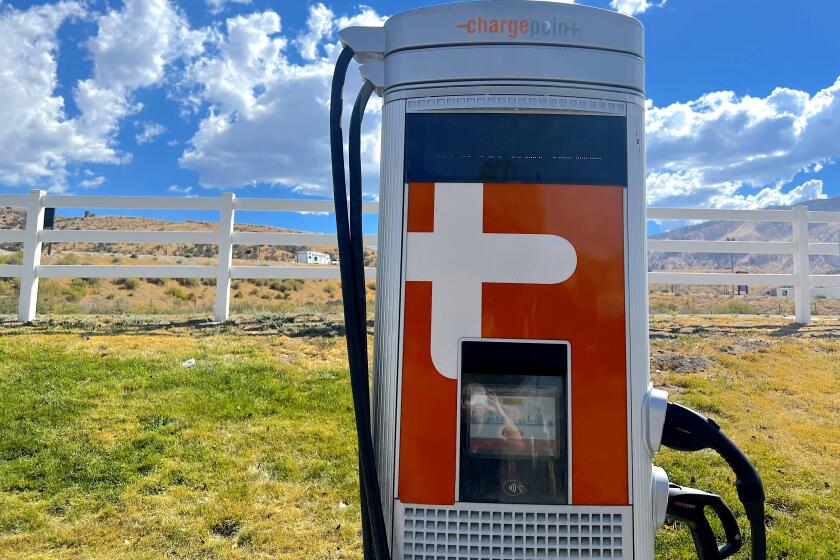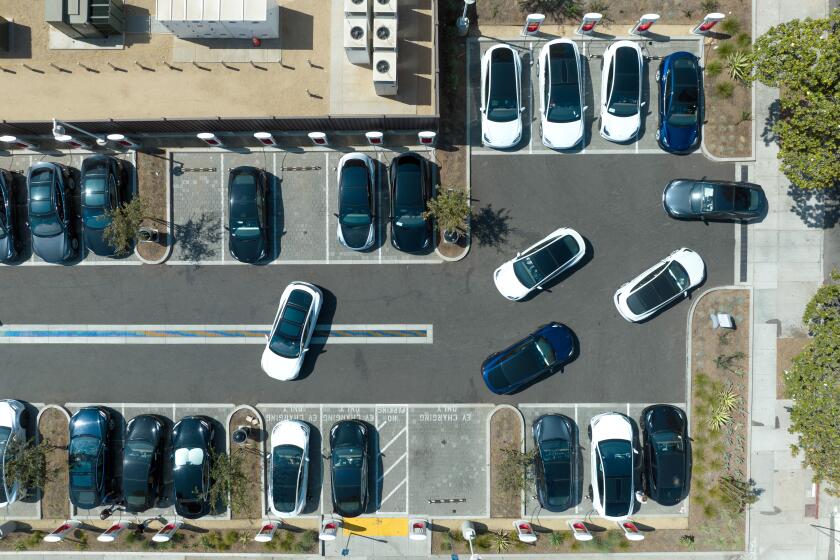Public EV chargers: Will they ever be as reliable as a gas pump?
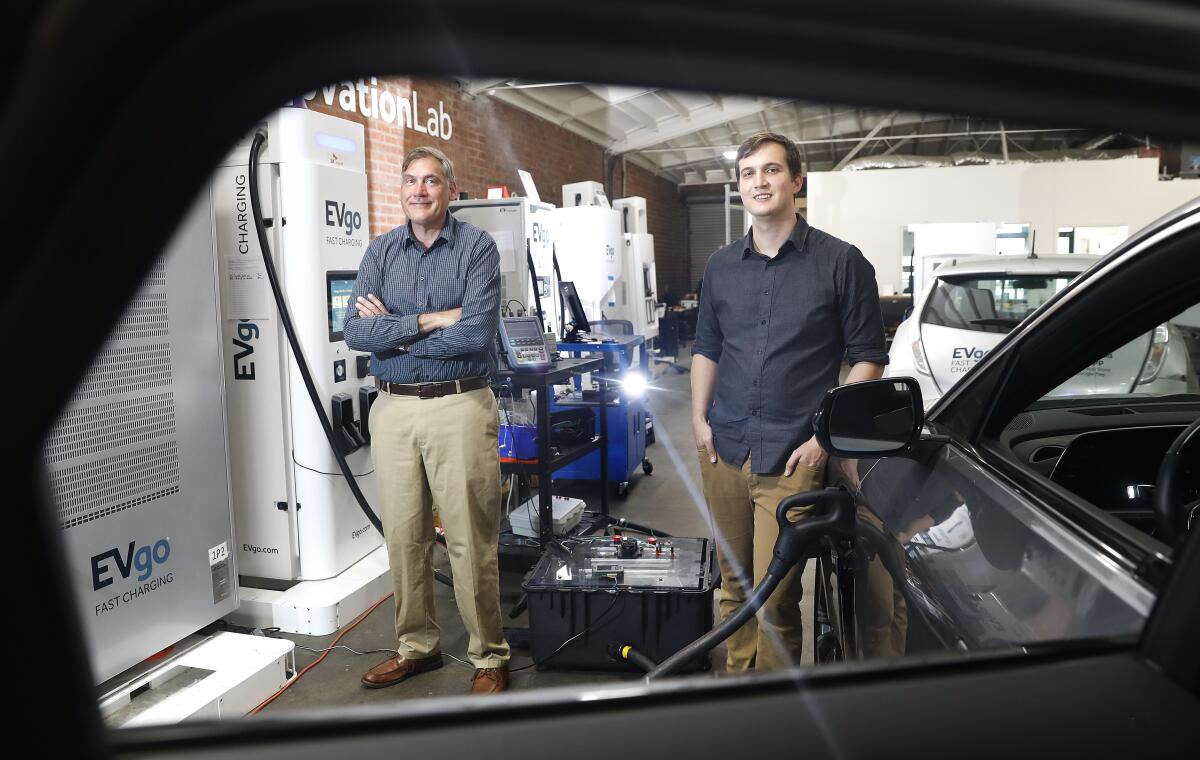
- Share via
This story originally published in Boiling Point, a weekly newsletter about climate change and the environment. Sign up here to get it in your inbox.
Hello. It’s autos reporter Russ Mitchell, filling in for Sammy Roth. My last newsletter tour of duty detailed the sorry state of EV chargers along Interstate 5. This time, I’m taking you on a trip to a charger manufacturer:
Bryce Wynter grips the handle at the end of an electric car charging cable. He raises his arm, then throws the heavy handle, hard. Deliberately. Onto a concrete floor.
“Sometimes people just toss the thing when they’re done charging,” he said. “We need to make sure it doesn’t break.”
The drop test is done from eight different angles. Sometimes the handle’s pounded with a heavy hammer. Then the thing and its cable are submerged in a big blue garbage-can-sized barrel, filled with saline solution, and left to soak. If it still works after all that, it clears another hurdle on EVgo’s reliability-test marathon.
A trip from the Bay Area to Southern California highlights the miserable state of the charging network available to many electric vehicle drivers.
Wynter is a systems engineer at the EVgo Innovation Lab in El Segundo. It’s located in a large brick-walled garage hidden behind a row of old houses.
Improving the reliability of the public chargers it sells and operates is a top priority at the lab. Thus far, though, the reliability record for public EV chargers is poor, not just for Los Angeles-based EVgo but for all of the many small companies hoping to grow big as the market for electric vehicles continues to expand.
“We want a great charging experience, fairly priced,” said Ivo Steklac, EVgo’s chief technology officer, speaking from a small screen held in the palm of an engineer’s hand, virtually tagging along on a lab tour via Zoom.
“You show up. The charger is ready,” he said. That’s the ideal.
The budding industry has a long way to go. In January, market research firm J.D. Power estimated that at least 1 in 5 attempts at public charging failed. The issue is causing many would-be EV buyers to question whether it’s time to make the switch.
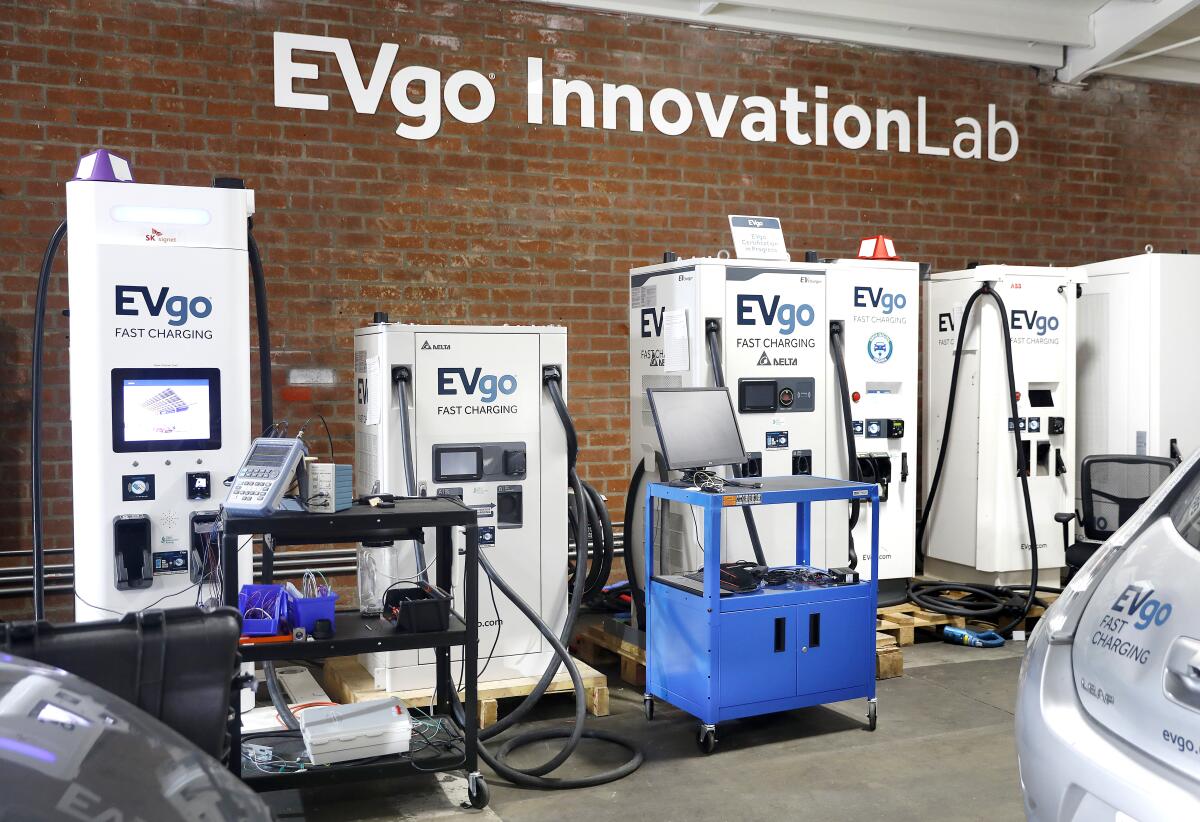
The uncertainty over whether the public charger a driver is heading for will be working adds stress to the idea of a long-distance EV drive. Burning gasoline pollutes the air and contributes to global warming, but gas station are plentiful — and the pumps are reliable.
EVgo knows this. Like all charger companies, it’s rapidly expanding its charger network with newer, better designed equipment. In January, EVgo launched what it calls its ReNew program, to overhaul existing chargers and replace many older ones, and to speed repair time when a charger needs fixing.
A lot can go wrong with an EV charger. Hardware can fail, and software, too. While a gasoline pump requires minimal software, a public charger must manage the delivery of electricity to a wide variety of electric vehicles with different kinds of batteries and proprietary battery management systems.
The charger is in effect a computer that juggles credit cards and phone payment apps, dependent on robust cellphone connections. The machines are packed with transistors and capacitors and power electronics that can fail.
The federal government, with billions of dollars to spend on charger subsidies, is aiming to reach 500,000 public chargers across the country by 2030. That’s 10 times more than exist today. To qualify for subsidies, the government will require 97% uptime reliability — but the details on what’s covered by that 97% is still being worked out at the state and federal level.
Plenty of challenges lie ahead as California mandates zero-emission cars, including cost and access to charging.
Market growth by itself will help improve reliability, the engineers at EVgo say. That’s because parts suppliers, some of whom were skeptical about market growth, were reluctant to adopt their products or work with charger companies on new designs — for parts that range from charging cables to digital power-delivery components.
At the El Segundo lab, 12 EVgo chargers are lined up against one long brick wall. “That’s every charger on our network,” said Keith Beckstead, EVgo’s director of charger engineering.
They range from medium-speed 50kw chargers — the original “fast chargers” — to ultrafast models that can reach 350kw — enough to go from almost empty to 80% full in 20 minutes or so if the car model can accept that fast of a charge. (Not all EVs can. Ask the dealer when you buy your car, or check your manual if you already have one.) There are also cabinets that hold racks of chargers that can allow, say, a Nissan Ariya and a GMC Hummer to charge from the same piece of equipment at the same time.
The economy’s switch to EVs is still in its early days and the fact that the automobile industry has yet not coordinated its charging protocols means that the digital “handshake” between a car’s software and a charger’s software is a common point of failure, and one that’s hard to diagnose.
EVgo borrows cars from auto manufacturers and tests them with its own equipment, in an attempt to minimize handshake problems.
“We walk down the line, testing every charger for every car,” said Wynter. That’s a time-consuming labor-intensive hassle. “Right now, that doesn’t scale,” he said. According to Steklac, EVgo is working hard to get automakers, other charger companies and industry standards bodies to agree on standards that could clear the path for the industry as a whole.
Only 10 electric and plug-in hybrid cars will qualify for the full tax credit in the U.S. out of 90 available EV options on the market.
Such standards usually take many years to develop. But time is short for the EV industry. Government mandates, such as California’s ban on new sales of gasoline and diesel cars as of 2035, have added heavy pressure.
If reliability doesn’t improve, and soon, those ambitious goals may prove impossible to reach.
On that note, here’s what else is happening around the West:
FLOODWATERS
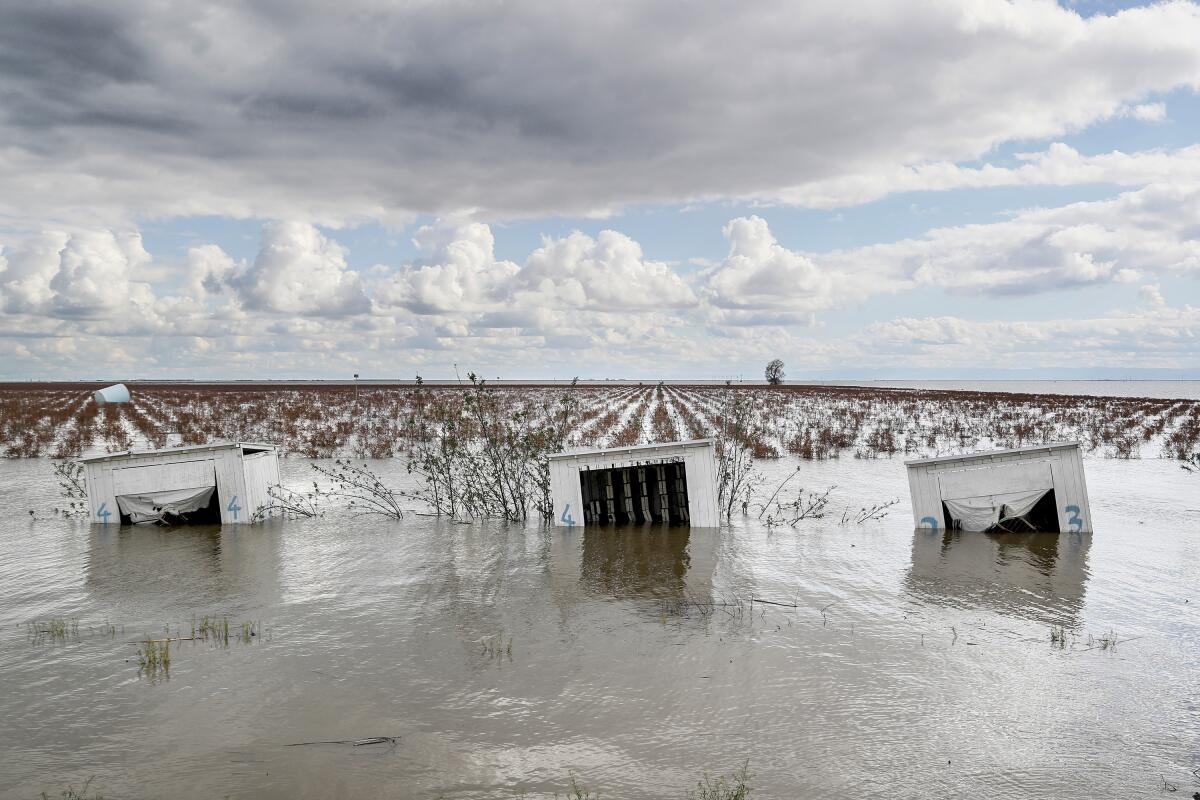
The worst of the melting snowpack from winter’s record rains is yet to come, Gov. Gavin Newsom said Tuesday on a visit to flooded towns and farmland in the Central Valley. Inspecting the waterlogged streets of Corcoran, north of Bakersfield, he said: “You can look at a scene like this and think the worst is going to recede, the worst is behind us, but in fact, quite the contrary.”
As reported by The Times’ Hayley Smith, farmers are now navigating fields normally planted with cotton, corn, wheat, tomatoes and other crops by boat, through the flooded Tulare Lake Basin.
Already suffering 50 breached canals, 37 destroyed homes, and 13 damaged bridges — in addition to the underwater cropland — an imminent heat wave with temperatures expected to reach nearly 100 degrees by Saturday will compound the misery. Both California State Prison, Corcoran, and the California Substance Abuse Treatment Facility — a dual prison complex that holds about 8,000 incarcerated men and employs many local residents — stand in the path of potential destruction.
Melted snow runoff could continue for another four months, Smith writes, and the lake basin, “which now sit like a bathtub with essentially nowhere to drain — could stick around for two years.”
THE ENERGY TRANSITION
Everything’s going electric in California, it seems – including hospitals. The UCI Medical Center in Irvine, now under construction, will be powered exclusively by electricity at its opening, now scheduled for 2025. No natural gas pipes will reach the building complex.
This is a hospital, though, so the question does arise: what about power blackouts? The hospital will have carbon-burning diesel generators on hand, reports Lilly Nguyen of the Daily Pilot. But Joe Brothman, the hospital‘s facilities director, said the goal is day-to-day operations running on 100% electric power.
And what about cargo ships? We won’t see battery powered container ships go beyond the experimental phase anytime soon, but electricity is making inroads. A fascinating story about shipping pollution in the Conversation points out that significant greenhouse gas reduction can result from something called “cold-ironing,” where a ship shuts down its engines and runs on electric current while in port. The ports of Los Angeles and Long Beach are leaders in cold-ironing. A new terminal with all-electric, zero-emission equipment opened at Long Beach in 2021, set up for cold-ironing. The Conversation piece goes deep on efforts around the world to clean up ocean shipping, and the political, economic and technological cross-current that get in the way.
ONE MORE THING
Back to electric cars: California exceeded its target of putting 1.5 million zero-emission vehicles on the state’s roads and highways – two years ahead of schedule. The San Diego Union-Tribune’s Rob Nikolewski reports that sales of EVs had been running flat but soared over the past two years, as more EV models from more carmakers hit the market.
“I think it’s a coming together of having the right policy standards as well as having the right market conditions,” said Josh D. Boone, executive director of Veloz, an EV advocacy group, told Nikolewski. Of course, that popularity puts even more pressure on the state and the charger companies that taxpayers are subsidizing to dramatically improve public charger reliability.
We’ll be back in your inbox next Tuesday, returning to the twice-a-week schedule we tested in February. To view this newsletter in your Web browser, click here.
Toward a more sustainable California
Get Boiling Point, our newsletter exploring climate change, energy and the environment, and become part of the conversation — and the solution.
You may occasionally receive promotional content from the Los Angeles Times.
